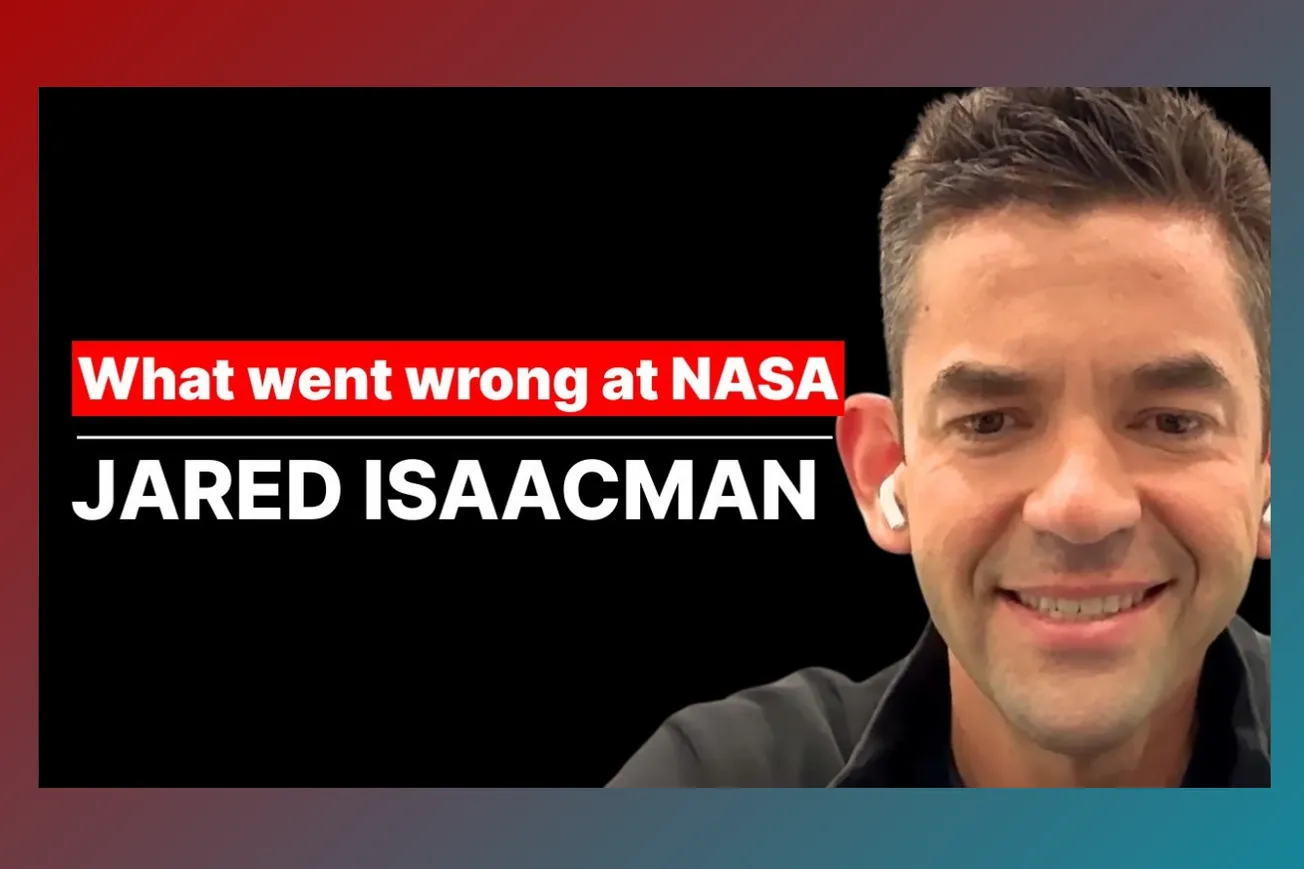Table of Contents
Jared Isaacman, Trump's withdrawn NASA nominee and first private citizen to spacewalk, exposes the crushing bureaucracy that's paralyzing America's space agency.
The billionaire entrepreneur and commercial astronaut shares explosive insights about government inefficiency, the China threat, and the political forces that derailed his nomination.
Key Takeaways
- NASA suffers from crushing bureaucracy with dozens of management layers where "everybody's got a deputy" preventing effective decision-making
- China gains massive second-mover advantage by building new facilities without bureaucratic baggage while America struggles with entrenched interests
- The proposed NASA budget cuts from $25 billion to $19 billion could force beneficial efficiency improvements rather than harm scientific progress
- Jared Isaacman's nomination withdrawal appears linked to anti-Elon Musk sentiment rather than his past Democratic donations as widely reported
- America spent over $100 billion on moon return promises for 35 years while China prepares to achieve lunar dominance first
- Commercial space companies like SpaceX enable $10 per kilogram orbital costs versus thousands for traditional government rockets
- Government should focus on impossible missions like nuclear propulsion while leaving routine launches to competitive private industry
Timeline Overview
- 0:00-1:10 Introduction — David Friedberg introduces Jared Isaacman's remarkable background and the controversial nomination withdrawal
- 1:10-7:15 Entrepreneur and Pilot Background — Building Shift4 from age 16, parallel aviation career, and creating world's largest private fighter jet fleet
- 7:15-16:37 Path to Commercial Astronaut — Meeting Elon Musk, Inspiration4 mission development, and becoming first civilian to spacewalk
- 16:37-31:52 NASA Nomination and Reform Vision — Trump's selection process, identifying bureaucratic problems, and plans for agency transformation
- 31:52-48:31 Budget Analysis and China Threat — Breaking down proposed cuts, space race dynamics, and private versus public industry roles
- 48:31-End Why Nomination Was Withdrawn — Political maneuvering around Elon Musk influence and resistance to government efficiency efforts
The Bureaucratic Crisis Paralyzing NASA
Jared Isaacman's six-month deep dive into NASA revealed a government agency suffocated by layers of management and bureaucratic processes that prevent the bold decision-making that once put humans on the moon.
- Dozens of management layers create decision paralysis with every position having deputies, associate assistants to deputies, and endless committees that dilute accountability and slow progress to glacial speeds
- 200-person meetings and endless review boards replace the focused mission-driven approach that characterized successful programs like the Manhattan Project and original Apollo missions
- Ownership gets pushed upward instead of downward unlike successful commercial space companies that empower smart people at lower levels to make critical decisions quickly and hold them accountable for results
- Congressional protection of local programs prevents resource reallocation from ineffective initiatives to mission-critical objectives, with senators defending small rocket clubs while China advances rapidly
- Status quo entrenchment across government agencies where bureaucrats wait out political appointees knowing they'll outlast any reform efforts through sheer institutional inertia
- Resource dispersion across thousands of small programs rather than concentrating efforts on breakthrough capabilities that only NASA can develop for national competitive advantage
This systemic dysfunction extends far beyond NASA, representing a government-wide crisis that handicaps American competitiveness against focused adversaries like China.
China's Devastating Second-Mover Advantage in Space
While America struggles with bureaucratic baggage accumulated over decades, China leverages fresh institutional structures to achieve rapid technological progress across multiple domains simultaneously.
- Fresh facility construction without legacy constraints allows China to optimize resources for specific missions rather than repurposing outdated infrastructure built for previous generation technologies
- Unified national focus eliminates competing interests that fragment American efforts across congressional districts and competing contractor constituencies protecting obsolete programs
- Rapid decision-making without bureaucratic layers enables China to move from concept to implementation while American programs spend years in review cycles and approval processes
- Space represents the ultimate strategic high ground with weapons, observation, and resource implications that could shift global power balance if America loses technological leadership
- Chinese rocket companies achieve vertical landing capabilities similar to SpaceX breakthroughs, demonstrating their ability to rapidly close technological gaps through focused investment
- Second launch frequency globally without reusability shows China's massive commitment to space dominance even before achieving cost-efficient rocket recovery like American companies
The space race isn't just about exploration—it's about maintaining American technological and strategic supremacy in the most important domain for 21st-century competition.
The Strategic Case for Controlled Budget Pressure
Counterintuitively, NASA's proposed budget reduction from $25 billion to $19 billion could catalyze beneficial changes by forcing focus on core missions rather than dispersed activities that dilute impact.
- Budget constraints force priority clarification by eliminating programs that exist primarily to justify organizational survival rather than advance critical national objectives
- Entrepreneurial decision-making improves under resource pressure as organizations become more innovative and efficient when forced to choose between competing priorities rather than funding everything
- Existing SLS hardware provides sufficient capability for initial lunar return missions without continuing expensive disposable rocket development that repurposes 60-year-old shuttle technology
- Commercial industry can handle routine launches while NASA focuses on breakthrough capabilities like nuclear propulsion that private companies cannot develop profitably
- Nuclear electric propulsion offers transformative potential for efficient mass transport to Mars and beyond, representing the kind of impossible mission only government resources can tackle
- Ten $100 million science missions annually could deliver more discoveries than single $3 billion flagship programs that take decades to develop and launch
- Time to science becomes a key performance indicator measuring how quickly discoveries reach humanity rather than accepting decade-long development cycles as normal
Strategic budget discipline redirects resources toward breakthrough capabilities that justify NASA's existence rather than activities private industry can handle more efficiently.
The Political Forces Behind Nomination Withdrawal
Jared Isaacman's nomination collapse reveals deeper tensions within the Trump administration between government efficiency advocates and traditional spending constituencies resistant to meaningful change.
- Anti-Elon Musk sentiment from influential advisors appears to have driven the nomination withdrawal rather than Isaacman's past Democratic donations, which were publicly known and disclosed
- Senate committee support remained strong with 19-0 committee vote and expectations of 70+ confirmation votes, indicating the withdrawal came from executive branch politics rather than legislative opposition
- Resistance to government efficiency efforts manifests through attacks on individuals associated with DOGE and spending reduction initiatives rather than direct policy opposition
- Entrenched interests fight change through personnel decisions by eliminating reform-minded nominees who threaten existing programs and spending patterns
- Deep state represents institutional inertia rather than conspiracy, with bureaucrats and contractors who benefit from status quo operations resisting efficiency improvements
- Political appointee vulnerability allows career officials to wait out reform efforts knowing that temporary leadership changes will restore previous operational patterns
- Mid-term election considerations may influence administration decisions to avoid controversy around spending cuts that could become campaign issues for opponents
The nomination withdrawal signals broader challenges facing government efficiency efforts when institutional forces align against meaningful change.
Commercial Space Revolution and National Strategy
The dramatic cost reductions achieved by private space companies create unprecedented opportunities for ambitious missions while requiring government focus on uniquely public capabilities.
- SpaceX's $10 per kilogram orbital costs represent 100x to 1000x improvement over traditional government rockets, making previously impossible missions economically viable
- Starship platform enables Mars colonization through massive payload capacity and reusability that transforms space economics from scarcity to abundance
- NASA's commercial crew program demonstrates successful partnership model where government defines requirements while private companies compete to deliver capabilities efficiently
- Nuclear propulsion requires government development because private companies cannot obtain insurance or regulatory approval for launching nuclear reactors despite their strategic importance
- International competition demands American leadership in breakthrough technologies that determine long-term strategic advantages rather than routine operational capabilities
- Resource allocation optimization directs private industry toward profitable activities while government tackles missions with no commercial business case
- Competitive pressure drives innovation more effectively than government monopolies, requiring agency evolution from operator to advanced research institution
Strategic partnership between government and private industry maximizes American capabilities while ensuring breakthrough technologies remain under national control.
Mars, Moon, and Long-term Space Strategy
America's space objectives must balance immediate geopolitical pressures with long-term species survival and exploration goals that justify massive public investment in space capabilities.
- Lunar return fulfills 35-year government commitment while providing testing ground for Mars technologies and potential resource evaluation before major investment decisions
- Mars colonization represents species insurance against existential risks while advancing human presence throughout the solar system for scientific and strategic purposes
- Economic and national security evaluation of lunar resources could determine whether permanent presence justifies continued investment or enables transition to Mars focus
- Nuclear electric propulsion opens outer solar system by providing efficient transport for massive payloads without dependence on solar power or complex refueling scenarios
- International partnership management requires balancing coalition benefits against program efficiency when allies contribute capabilities that may not optimize mission success
- Scientific discovery acceleration through rapid mission deployment could restore public excitement about space exploration while advancing human knowledge
- Commercial industry maturation will eventually handle routine Mars transport, allowing government focus on further frontiers and breakthrough technologies
Long-term space strategy requires coordinated efforts across government and private industry to achieve both immediate geopolitical objectives and transformational human expansion.
Common Questions
Q: Why was Jared Isaacman's NASA nomination really withdrawn?
A: Appears linked to anti-Elon Musk sentiment from influential advisors rather than his Democratic donations, which were publicly known when nominated.
Q: How does China threaten American space leadership?
A: China builds new facilities without bureaucratic baggage while America struggles with entrenched interests, achieving rapid progress in rockets and space capabilities.
Q: Would NASA budget cuts harm scientific progress?
A: Controlled budget pressure could improve efficiency by forcing focus on breakthrough missions rather than dispersed programs that dilute impact.
Q: What should NASA focus on versus private companies?
A: NASA should tackle impossible missions like nuclear propulsion while private industry handles routine launches more efficiently through competition.
Q: Is the space race with China really important?
A: Space represents strategic high ground with weapons, observation, and resource implications that could shift global power balance if America loses leadership.
Conclusion
Jared Isaacman's experience reveals that America's space challenges reflect broader government dysfunction where bureaucratic inertia prevents the focused decision-making required to maintain technological and strategic leadership. His vision for NASA reform—eliminating bureaucratic layers, concentrating on breakthrough missions, and partnering strategically with private industry—offers a path toward restoring American space dominance.
The stakes extend far beyond space exploration to fundamental questions about American competitiveness and the ability to execute ambitious national objectives in an era of intensifying global competition with strategically focused adversaries like China.









